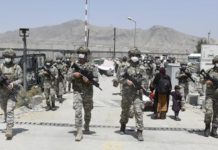
WASHINGTON – The White House has announced a three-phase plan for restarting the U.S. economy, but experts said the continuing lack of vital public health tools to fight COVID-19 mean it’s risky to even move to phase one.
Lack of capacity to test for the coronavirus and a lack of staff to trace people who may be infected mean the United States may not be ready to reopen without risking major blowback, experts said.
“There is a distinct risk that we will just bump straight back up and we’ll see a brisk increase in the number of infections,” said John Lynch III, a University of Washington infectious diseases professor and a board member of the Infectious Diseases Society of America.
Starting with California on March 19, governors began issuing orders closing businesses, canceling events and urging people to stay home.
The toll on the U.S. economy has been devastating. More than 20 million people have filed for unemployment benefits. With political pressure building to get people back to work, the Trump administration Thursday issued guidelines for lifting social distancing requirements.
Under the new guidelines, states showing a “downward trajectory” of cases over 14 days can move into the first phase, which includes reopening large venues such as movie theaters, sports stadiums and religious institutions “under strict physical distancing protocols.” Employers can bring workers back “in phases.” Restrictions ease further in phases two and three.
Loosening restrictions depends on having a “robust testing program” for health care workers and screening for people with possible symptoms of COVID-19. It also calls for specialized sites to be screening asymptomatic people for the virus that causes the disease.
That capability doesn’t exist at the moment, said William Hanage, associate professor of epidemiology at the Harvard T.H. Chan School of Public Health.
“The state of testing is such that we’re not really ready to be moving into stage one anywhere,” he said.
Lynch estimated that Harborview Medical Center in Seattle, where he is associate medical director, is performing roughly 5,000 tests per day. But he said they need to be doing 10,000 to 20,000. And, he said, tests need to be available to everyone across the country, regardless of whether they have health insurance.
“We’re going to need several-fold higher capacity in addition to access,” he said. “I think that there’s still a long way to go on getting to that point.”
About 150,000 tests per day are performed around the country, according to the COVID Tracking Project.
“We still probably need to be doing three times more testing than we’re doing now,” said Dr. Ashish K. Jha, director of the Global Health Institute at Harvard University. “I don’t see America getting by anytime soon with 100,000 to 150,000 tests.”
An unknown percentage of people have been exposed to the virus without getting sick. They may have antibodies in their blood that protect them from getting infected again, but scientists don’t know how strong that protection is or how long it lasts.
Blood tests may soon be available to answer those questions. But antibody testing capacity is even further behind virus testing, Harvard University assistant professor of epidemiology Michael Mina said.
“We’re not anywhere close to where we need to be,” he said. “I think we’re going to see something with the demand for antibody testing that’s going to make the demand for (virus) testing look minimal.”
Once infected patients are identified, health officials need to be able to trace the people with whom they have come in contact and isolate them. It’s an extremely labor-intensive process, requiring tens of thousands of public health workers.


























